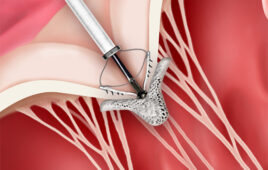DANVILLE, Calif.–(BUSINESS
WIRE)–VasoStitch, a start-up medical technology company,
announced today that it has successfully completed its first in vivo study of
its percutaneous access-and-closure system for the nonsurgical deployment of
large-diameter transcatheter therapeutic devices, such as Transcatheter Aortic
Valve Implants (TAVI) and Endovascular Aneurysm Repair (EVAR) devices. The
VasoStitch system is designed to reduce procedural complexity and eliminate the
need for an “open” surgical procedure.
The challenge with percutaneous catheter-based cardiac
procedures is that a surgical cut-down is required for access and then closure.
VasoStitch has developed two platform technologies designed to access and close
percutaneous therapy sites without the need for open surgery, thus making
catheter-based interventions simpler and more accessible.
“Current surgical means of arterial or cardiac access and
closure for large diameter catheter-based interventions adds about an hour to
an already long and complex procedure. A device that can replicate the current
‘gold standard of surgical access and repair in a more rapid and facile
fashion will reduce healthcare costs dramatically, enhance adoption of
large-diameter cardiovascular and endovascular therapies, and improve the
efficiency of patient management,” said David W. J. Smith, President and CEO of VasoStitch. “We now
look forward to our First-in-Human milestone.”
VasoStitch was founded by Amir Belson, MD. Dr. Belson
previously founded NeoGuide Systems, a company that developed platform
technology for minimally invasive surgical procedures and was acquired by Intuitive
Surgical in 2009; more recently, Dr. Belson also has founded Emboline, Vascular
Pathways and ZipLine Medical.
About VasoStitch
VasoStitch is an emerging medical device company that is
developing nonsurgical transfemoral and transapical access-and-closure systems
to facilitate deployment of large-diameter transcatheter therapeutic
devices-designed to reduce procedural complexity and eliminate the need for an
“open” surgical procedure.
Posted by Sean Fenske, Editor-in-Chief, MDT




